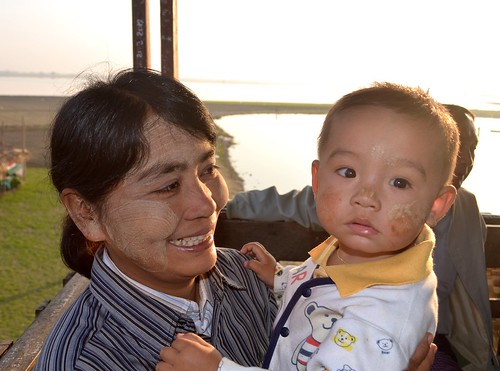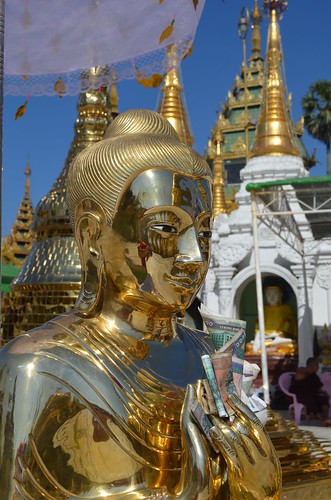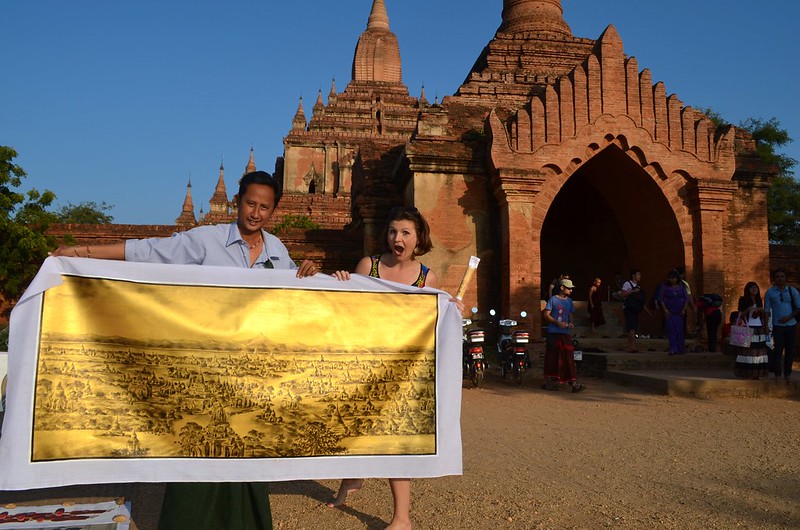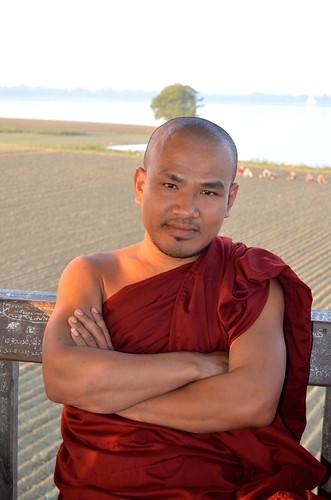#

Burmese is a language that can be “hacked” or learned quite quickly in comparison to other languages. Here’s my story on how I learned survival Burmese and how it colored my recent travels in Burma.
“I think the driver thinks I’m fluent in Burmese,” I said to my fellow horse cart companions as we ambled through Inwa aka Ava, the ancient Burmese capital near Mandalay.
It was a sunny day and we’d arrived around mid-day after a stop over at the Snake Pagoda en route. The day before, my British and Italian travel buddies had seen me manage a few previous Burmese exchanges at a restaurant and with various hawkers along the U Pain bridge, so it wasn’t such a surprise to them.
On this day, I managed to impress myself. When I first met our horse cart driver, I’d said a few things in Burmese like how much? and that it was hot today. Subsequently, once we had paid and started forward, I managed to comment on a few more things and successfully answered his question about whether we’d eaten or not and about stopping at a restaurant along the way.
I guess for him these few minutes of my Burmese were enough, and he proceeded to point out several features and places to me in Burmese. Deadpan, he thought I spoke fluent Burmese.
I can’t claim to have caught all the meaning, but based on the context, I had a pretty good idea of what he was talking about. Most importantly he at least thought I understood.
At that point in my trip, I’d spent about 8 days in Myanmar. In the lead up to my trip, I’d spent about 2 weeks preparing and around 10 hours in total of self-study on the Burmese language.
While I can’t claim to have become fluent in that time, I can claim to have successfully “hacked” Burmese. By “hacked” I mean that I was able to quickly jumpstart my learning of this foreign language in order to get through basic language exchanges and conversations. That was my goal. That was what I achieved.
Here’s how I prepared, what I learned and some anecdotal stories during my trip speaking Burmese.
Summary of How I Learned Travel Burmese

(If you are interested in a fuller description of this, I’d recommend you check out my article “Hacking Burmese: Learning Burmese Essentials Fast”, which provides a few more details.)
Basically, I had decided to learn some Burmese since I knew I would be traveling there. My brother and his wife wanted to visit Burma over the winter holidays and, since I was already in Asia, the timing lined up.
After some initial research, I found a free book and audio files to use (“Burmese by Ear”). I then chopped up the lessons into individual audio files and phrases and created my Memrise Course for Beginner Burmese.
From there, I just proceeded to study and learn the language in a systematic way:
- For new words, I created mems or visual mnemonics in order to make that piece of vocabulary stickier or more memorable for me to remember.
- I then reviewed the words following spaced repetition learning method or, to borrow an analogy from Memrise, I’d plant the word, water it, and grow it into memory maturity.
- Finally, as these phrases entered my vocabulary, I attempted to enact these new phrases in my daily life.
Here’s a breakdown of the actual study time:
- meta-rearch time (3h15)
- course creation (6h30)
- Memrise learning time is (7 hours and 31 minutes)
- 50 study sessions over two weeks
- Most of the individual study sessions were only a few minutes. There was one session over 23 minutes and a few at over 10 minutes.
- Learned 150 Burmese items, including various vocabulary, phrases and pronunciation.
- So, at 451 minutes (7 hours and 31 minutes) of study time, that equals about 3 minutes per item.
Since then, I’d done a bit more of review time and have started work on creating my Burmese by Ear: Units 3-8 Memrise course. Since internet had been that fast or reliable, I was able to work much on this. So, most of the Burmese I learned before I had arrived and simply learned to play around with the vocabulary I had to creatively speak more meaning with the same amount of words.
So, you live in Yangon?

While at the time of this post writing I’d only been in Myanmar about 2 weeks, I think I can claim to have successfully “hacked” the Burmese language. In fact, I’d say I had managed this feat within my first day or so of arrival.
Like most tourists to Yangon, my brother, his wife and I started our trip by visiting the Swedagdonn Pagoda. After a quick lunch, we walked to the top of the hill where this old religious site is situated. We bought our entry tickets and found a guide around the complex.
Our guide gave us a really nice tour and introduction to the country. While he, of course, spoke in English, I managed to make a few comments in Burmese, which he smiled and seemed to have enjoyed. During my Burmese language studies, I’d picked some anecdotal knowledge about Burmese culture and people that helped color my questions.
Towards the end of the tour, the guide asked if I liked living in Yangon. I responded that I’d only been there one day. Apparently, he didn’t understand how a tourist would learn their language on their own before arrival.
It’s Expensive. It’s Cheap. It’s not expensive
During my preparation studies, I’d learned several expressions like it’s expensive and it’s cheap. In Yangon, we didn’t do much shopping but in Bagan, there were a lot interesting things to buy. This was a great opportunity for me to practice my numbers and negotiating skills.
While most of the sellers knew enough English to tell you the price in English or various other languages, it was interesting to see their smiles when I asked them how expensive it was in Burmese. Sometimes they’d respond in English, other times in Burmese. In either case, there was a kind of eye-blinking delay as they sized me up.

In Bagan, I approached the shopping situations as chances to practice the phrases I knew like it’s cheap or it’s expensive. These worked great and got colorful responses from Burmese people.
Overall though, I got my best responses when I said something was NOT cheap (ze ma c’o ba bu). This was not a phrase I’d learned, but an attempt to use the negative form with a phrase I did know (it’s cheap).
In one instance, when my sister-in-law was pursuing a large painting, I walked up and delivered this line and the 3-4 painter/sellers all laughed. They also knew we meant business when it came to negotiating the price.
It’s alright, isn’t it? Yeah, it’s alright.

Most tourists during their stay in Myanmar can manage to learn hello (min ga la ba) and thanks (ze co deh), but one expression / language chunk has really worked wonders for me: Ya deh naw? (It’s alright, isn’t it?)
Whether it was negotiating our first taxi or various other situations since, the phrase “Ya deh naw?” and “Ya ba deh” (It’s alright) have served me well. It’s also an expression you’ll here in normal situations between Burmese situation, so not only does it work, it’s the same one locals will be using.
During my travels here, I’ve found Burmese people to be very pleasant and smiling. Adding a few local expressions to your baggage will add even more happiness to the local people.
Conclusion: You can learn Burmese too
Unlike Chinese or Vietnamese, which both present major early challenges for proper pronunciation and comprehension, I find Burmese to be a much more approachable Asian language. There are some minor, emphasis tones and some particular pronunciation points, but you don’t have to worry much about this initially in order to get through some basic “first needs” situations.
Burmese, like Chinese and some other languages, doesn’t have a huge grammar and doesn’t have form changes. So, to talk about the future or past you simply add another word and use the same verbs like in the present tense.
Burmese is a language you can hack or jumpstart in a few hours of of preparation in the few days or weeks leading up to your trip.
In my case, I had to invest some extra time preparing learning resources, but my guess is that someone else could use my same Memrise course and get through it in maybe 3-5 hours total. In order to better remember, you’ll need to review. I’d also recommend you spread your learning out over multiple sessions over a few days.
Once you’ve “mastered” that first course of only 150 words and phrases you’ll actually be able to manage quite a few situations. It’ll give you lots of basic vocabulary, especially numbers, and speaking structures for using those phrases. Subsequently you can add more vocabulary via the later units presented in “Burmese by Ear: Units 3-8”.

As hopefully these pictures and anecdotes show, Burmese people are extremely friendly. In general I found people knew enough English to get through most of my travel situations. Hotels, guides and tourist spots will know enough English to help you. As such, it’s not really necessary to learn Burmese to travel in Myanmar.
Burmese isn’t that hard initially and you can learn Burmese too. It’ll make your trip more colorful and help show respect to the local people and culture.
Personally, I know preparing and studying the local language before my travels seems like a lot of work (and it is!). There have been times in Myanmar where my effort to listen and pay attention to the local language made traveling there more challenging but I like it. It’s a good challenge.
During lunch with a travel companion in Mandalay, I commented that learning the local language tends to make my trip a bit more tiring. Learning a few phrases will mean you have to pay attention to the responses. You can’t just tune out anymore.
He responded heartily, “Isn’t that just how you like to travel?”
It is indeed just how I like to travel.
